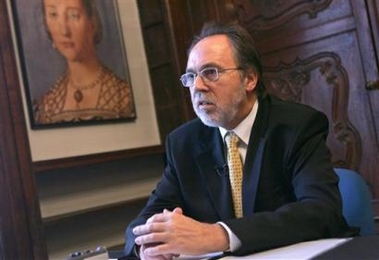|
EU investigator seeks data on CIA planes
(AP)
Updated: 2005-11-23 08:45
The head of an investigation into alleged secret CIA prisons in Eastern
Europe said Tuesday he was checking 31 suspect planes that landed in Europe in
recent years and was trying to acquire past satellite images of sites in Romania
and Poland.
If the European probe uncovers evidence of covert facilities, the potential
impact ranges from major embarrassment for the United States to political
turmoil in countries that might have participated, even unwittingly. Countries
found housing secret detention centers also could be suspended or expelled from
the 46-member Council of Europe, a human rights watchdog organization.
In an interview with The Associated Press, Swiss senator Dick Marty said the
Council of Europe, on whose behalf he was investigating, had a "moral
obligation" to look into claims the CIA set up secret prisons on the continent
to interrogate al-Qaida suspects.
He said that despite lack of proof, there were "many hints, such as
suspicious moving patterns of aircraft, that have to be investigated."
But given the limited powers of the Strasbourg-based council, Marty's chances
of uncovering explosive state secrets seemed unclear. The U.S. government has
neither confirmed nor denied the existence of such facilities.

Dick Marty, a Swiss senator leading a European
probe into alleged secret CIA prisons in eastern Europe, presents a first
report on his work at a closed meeting of the human rights watchdog's
legal affairs committee in Paris, Tuesday, Nov. 22, 2005.
[AP] | Allegations the CIA hid and interrogated key al-Qaida suspects at Soviet-era
compounds in Eastern Europe were first reported in The Washington Post on Nov.
2. The paper did not name the countries involved.
A day later, Human Rights Watch said it had evidence indicating the CIA
transported suspected terrorists captured in Afghanistan to Poland and Romania.
The New York-based group identified the Kogalniceanu military airfield in
Romania and Poland's Szczytno-Szymany airport as possible sites for secret
detention centers, saying it based its conclusion on flight logs of CIA aircraft
from 2001 to 2004 that it had obtained.
In a report presented in Paris on Tuesday to the legal affairs committee of
the Council of Europe's parliamentary assembly, Marty said other airports that
might have been used by CIA aircraft in some capacity are Palma de Mallorca in
Spain, Larnaca in Cyprus and Shannon in Ireland.
Marty's report — a copy of which was obtained by the AP — contends the
aircraft are "alleged to belong to entities with direct or indirect links to the
CIA. It is claimed these were used by the CIA to transport prisoners."
He said he asked the Brussels, Belgium-based Eurocontrol air safety
organization to provide details of 31 suspect planes that flew through Europe,
in accordance with a list given to him by Human Rights Watch.
Member states send Eurocontrol — also known as the European Organization for
the Safety of Air Navigation — flight logs of both civilian and military
flights, but these are not published.
Marty also said he asked the European Union's Satellite Center in Spain to
look up and hand over satellite images of suspect sites in Romania and Poland.
"When we talk about 'prisons,' they don't necessarily have to be for many
people, they could be cells for a very small group of people, one or two," he
said.
Marty said he was planning to ask authorities in the Council of Europe's
member states whether they have been contacted in order to "authorize secret
detention in one form or another."
He also said he intended to ask Massachusetts Sen. John Kerry, the Democratic
presidential nominee in 2004, to share any information the Senate may get from
Defense Secretary Donald H. Rumsfeld on the possible existence of secret
detention facilities outside the United States.
Earlier this month, the Senate approved a proposal by Kerry to require
National Intelligence Director John Negroponte to provide congressional
intelligence committees with details of any clandestine facilities where the
United States holds or has held terrorism suspects.
A Kerry spokeswoman, April Boyd, said the senator was not inclined to honor
Marty's request because it would require him to disclose classified information.
"Senator Kerry stood up to hold this administration accountable and
re-establish congressional oversight because he was deeply concerned about what
he'd read in the newspapers about alleged secret prisons," Boyd said. "But
classified information cannot be shared with outside groups or the news media."
On Tuesday, several EU countries — including Britain, the Netherlands and
Finland — agreed to write the United States on behalf of the European Union
requesting clarification of the reports of secret prisons.
Marty said the probe was not meant to spark anti-American feelings or
question the U.S. fight against terrorism.
"This is absolutely not a crusade against America. I think all Europeans
agree with Americans that we must fight terrorism," he said. "We do not want to
weaken the fight against terrorism ... but this fight has to be fought by legal
means. Wrongdoing only gives ammunition to both the terrorists and their
sympathizers."
The Council of Europe is the guardian of the European Convention on Human
Rights, a legally binding human rights treaty signed by all 46 council members.
The council itself has no direct jurisdiction over any country but can exercise
political pressure.
Membership in the organization is considered prestigious for European
countries as it attests to their attachment to Europe's human rights
principles.
|